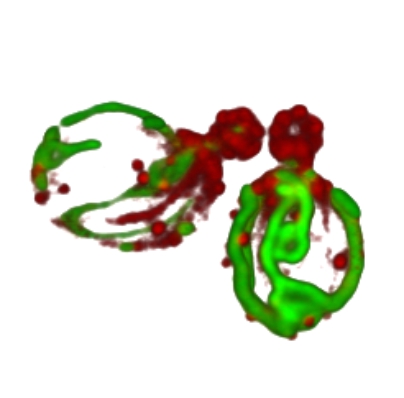Research Westermann Group: The Molecular Machinery of Mitochondrial Dynamics, Inheritance, and Architecture
Each type of eukaryotic cell has a characteristic three-dimensional structure. Maintenance of its architecture and duplication during cell division depend on active transport of organelles along the cytoskeleton and continuous fission and fusion of intracellular membranes. Mitochondria are essential organelles, which are often located at sites of high energy consumption in the cell. They cannot be formed de novo, but have to be inherited during cell division. Positioning and transport of mitochondria and maintenance of mitochondrial function are controlled by the cytoskeleton and depend on fusion and fission of their membranes. These processes are functionally linked to the machinery that maintains the complex architecture of mitochondrial inner membrane cristae. We use the budding yeast Saccharomyces cerevisiae to study these processes. By studying mitochondrial morphology and inheritance we can learn a lot about many different aspects of organellar biogenesis, such as partitioning of organelles during cell division, transport of membranes along the cytoskeleton, intracellular membrane fusion, cellular aging and much more.
Asymmetric inheritance of mitochondria in yeast (DFG We 2174/7-1)

During cell division not only the chromosomes in the nucleus, but also all membrane-bounded organelles have to be inherited by transport and partitioning mechanisms. In some cell types – such as stem cells or budding yeasts – asymmetric cell division produces cells with different properties. During stem cell division young and undamaged mitochondria are maintained in the stem cell lineage, whereas in yeast cells young mitochondria are preferentially inherited from the mother to the bud. The molecular mechanisms of asymmetric partitioning of mitochondria and the selection of the "fittest" organelles are largely unknown and will be investigated using baker’s yeast Saccharomyces cerevisiae as a model system. Our previous results show that the myosin motor protein Myo2 transports mitochondria along actin filaments into the bud, while at the same time some mitochondria are anchored by specific protein complexes to the plasma membrane of the mother cell to retain them. The mitochondrial outer membrane protein Alo1 is a novel interaction partner of Myo2, and we are investigating its role in the protection of mitochondria against oxidative damage and the selection of the "fittest" mitochondria for transport into the bud. Ufo1 is a genetic interaction partner of Myo2 and presumably plays an important role as a subunit of an ubiquitin ligase in the regulation of mitochondrial inheritance. Cytosolic protein aggregates which are generated by heat shock or aging are recruited to the mitochondrial surface to retain them in the mother and prevent their inheritance to the daughter cell. Promising preliminary results show that the mitochondrial protein import machinery plays a crucial role in immobilization of these aggregates. The mechanisms of retrograde mitochondrial transport are almost completely unknown and presumably are based on binding of mitochondria to actin cables that grow from the bud neck towards the mother cell. The investigation of these processes promises a detailed understanding of the processes that determine the asymmetric inheritance of mitochondria and consequently cellular aging.
Sequence Information for mtGFP Plasmids
